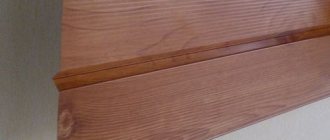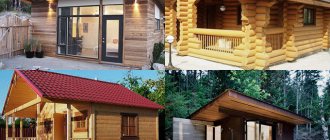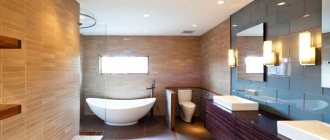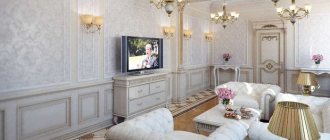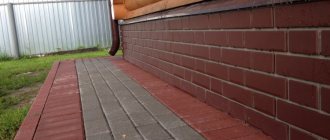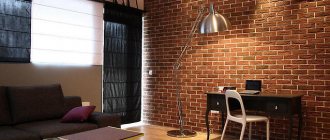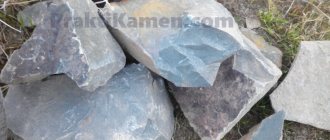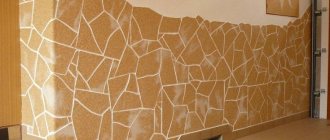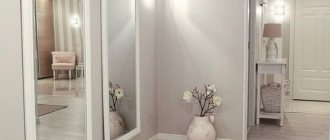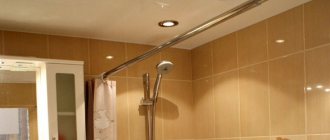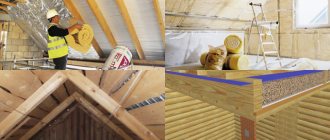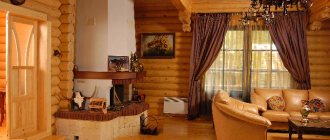Kinds
Manufacturers use the following materials to produce stone siding:
Metal
Made of galvanized steel with a polymer protective coating.
The stamped relief, repeating the texture of various types of masonry, is covered with several protective and decorative layers, resulting in a panel with a very authentically made surface.
The material is somewhat thicker than conventional metal siding, which increases the overall weight of the skin, but the strength of the fabric is much higher, and the reliability of such skin is very high. At the same time, stone-look metal siding is almost twice as expensive as vinyl samples.
Vinyl
Vinyl siding is lightweight, which reduces the load on the supporting structures of the house. This makes it possible to finish buildings with a large wall area without overloading them with additional elements.
In addition, the specificity of plastic provides ample opportunities for high-quality imitation of the texture of stone with maximum accuracy and reliability.
The shapes for plastic panels are copied from natural masonry, and the properties of the plastic make it possible to make the surface as close as possible to natural granite, sandstone or marble.
One of the weaknesses of vinyl siding is its relatively low strength and fragility in cold weather, which requires careful handling of the skin.
In addition, vinyl expands quite strongly when heated, so this feature must be taken into account during installation.
Acrylic
Acrylic stone siding has almost the same characteristics as vinyl siding, although the production technology is different. The material is more resistant to heat and is neutral to a number of chemicals. Slightly more expensive than vinyl.
Fiber cement
Fiber cement siding is a new product in the Russian market, although it has been used in the West for a long time. The material is extremely durable, resistant to atmospheric and mechanical stress.
Information about it is quite scarce, but we can definitely say that it is very heavy (1 sq. m. weighs about 15 kg, a fully paneled house will receive an additional load of several tons), the thickness of the panels is 10 mm.
In addition, such material is very expensive - the cost of fiber cement panels exceeds even the most expensive wooden samples. Such qualities significantly reduce the interest of homeowners, although manufacturers claim the unsurpassed properties of the material.
IMPORTANT! When choosing a material, you should familiarize yourself with its characteristics, since the constant search for new, more durable and reliable types of cladding brings improved types of siding to the market, often without the disadvantages of earlier models.
Prices for materials and labor
The specific price for facing material depends on many factors, including the name of the manufacturer, the materials used for production, decorative patterns, and much more. Much depends on how production is organized.
The price for plastic stone-look panels is in a fairly wide price range. On the market you can find panels ranging from 300-2000 rubles. Depending on the region, the cost may also fluctuate.
The design and decorative design of the panels plays a big role in determining the price. So, a material like “rocky stone” will cost about 400 rubles, but the “natural stone” collection will cost more (about 500-600 rubles).
Prices are indicated for a package of 10 panels. Since the assortment of manufacturers is approximately the same, this amount is enough to cover approximately 5-6 squares.
Speaking about the cost of work, the specific price will depend on the complexity of the design, the area of the building and the pricing policy of the craftsmen. On average, prices currently fluctuate within the following range:
| Type of work | Cost per 1 sq. m, rub. |
| Facade preparation | 200 |
| Installation of sheathing | 400 |
| Installation of insulation | 400 |
| Preparing the frame for the panels | 600 |
| Installation of panels under stone | 700 |
Using stone siding
Although the material itself looks quite beautiful, it is important to choose the right pattern for the aesthetic design of the external or internal walls of a building
Exterior siding
The finishing of building facades with siding must be provided for at the construction stage. If you decide to cover all the walls with this decorative material, it is better to give preference to vinyl panels, which are light in weight and will not create additional pressure on the box. For powerful concrete and brick buildings, the choice of material can be anything. When choosing a material pattern, it is worth considering that large stonework looks great on large buildings, but for a small house it is better to choose a material that imitates small stone.
In buildings with several floors, stone-look siding is used to decorate, in most cases, individual architectural elements: partially walls, a plinth, a bay window, etc. The exterior decoration looks beautiful when delineating the surfaces of the plinth and walls by using different siding textures and its shades. If there are several buildings on the site (a gazebo, a bathhouse, etc.), they can be decorated in the same style as the house, using the same texture of the material - this option will look very stylish, emphasizing the excellent taste of the owner and the beauty of the stone surrounded by greenery.
The stone goes well with other types of finishing, for example, with decorative plaster, wood, and blockhouse. In the photo you can see the magnificent tandem of stone siding that marks the central part of the building, with smoothly plastered walls and entrance columns. A striking example would be modern chalet-style houses, where the lower part of the building is decorated with basement siding, and the top is made of wood or materials imitating it.
Stone siding in the interior
In modern interior decoration, the most popular lately is siding that imitates brickwork. It can become a worthy decoration for a cozy living room; sometimes the material is used to decorate a kitchen space, but it is better to be careful not to place it near the fire. In the corridor, imitation of natural stone is used, as a rule, sporadically - corner areas, niches, and doorways are decorated with siding. You can also find this type of decoration on balconies, which will look warm and cozy even in the cold winter.
Methods of using sading in the interior and exterior
Basement siding is a wide range of panels in a wide variety of relief patterns, shapes and shades. Such a variety of varieties is not present in every decorative material. At the same time, the installation of vinyl and cement panels is carried out both on the facade of buildings and in the premises. Walls can be decorated completely or in separate areas, combined with other modern finishing materials. For example, rocky terrain looks great with smooth plaster. Imitation cobblestones on the base are combined with conventional siding panels on the facade, but are in no way suitable for a small house with a high base.
There are a lot of combination options, so the design of the building must be carefully thought out and the best chosen. Optimal is the visual distinction between the basement of the building and the wall; for this, you can select facing materials of different textures or shades. Siding can be used to cover hallways, kitchens, lobbies of hotels and public institutions. The choice of options is always large, the main thing is to find the only correct solution.
Description of basement stone siding
Basement siding was created for a specific task - the design of the lower part of the house foundation protruding from the ground. Because of this, the basement siding completely repeats the texture of stone or brickwork - a common situation for wooden houses with a stone foundation.
The difference in the sizes of the panels compared to conventional types of siding is also caused by the specifics of the plinth cladding (mainly) and the peculiarities of the texture of the material. The masonry consists of relatively small fragments, so the panels can only be joined along the line of connection of individual decorative elements.
Hence the peculiar shape of the sheets of basement siding, which can be assembled into a sheet of any size, but the joint lines of individual panels are difficult to see even close up.
Quite soon it turned out that basement siding was no worse than usual when completely finishing the house. The appearance of the cladding is very precise, stylish and harmonious.
The variety of types of imitation natural stone in the assortment makes it possible to transform the facade of an ordinary house into an ancient building, repeating in its appearance good-quality houses made of natural stone. Such finishing radically changes the appearance of the house, leaving its architecture intact and without requiring large expenditures.
Advantages and disadvantages of siding
Over the past few years, siding has quite naturally occupied the title of the best finishing material. This is due not only to its versatility, which many buyers pay attention to. The main reason for its popularity should be called a reasonable combination of “quality and cost”.
Owners who are faced with a variety of problems often think about buying siding. Some people need a material that will give their home a more interesting appearance. Others want to provide additional protection to their walls from the negative effects of weather conditions. Still others intend to create a specific architectural design on a budget. And siding is ideal for each category of buyers, as it can satisfy their needs.
This type of siding has the following set of positive qualities:
- a wide range of;
- ease of care;
- light weight;
- simple installation technology;
- possibility of covering frame buildings;
- improved heat-saving and sound-proofing characteristics;
- fire resistance;
- moisture resistance;
- aesthetic appearance;
- insusceptibility to low temperatures.
But it also has certain disadvantages:
- the likelihood of purchasing a counterfeit or defective product;
- short service life compared to natural materials.
The greatest risk of running into defects occurs when purchasing products from unscrupulous manufacturers. Therefore, you should not hastily buy siding for cladding at an incredibly low price. The reduced cost should raise doubts in the buyer about the performance characteristics of the product.
Poor quality panels are usually the result of a violation of siding manufacturing technology. Such products break quickly and can easily be destroyed by the slightest damage or during processing. A fake quickly loses its original appearance and is irreparable.
Kinds
There are several types of stone basement siding:
- Stone;
- Rubble stone;
- Granite;
- Sandstone;
- Canyon;
- Rocky stone;
- Neapolitan stone;
- Florentine stone;
- Venetian stone, etc.
Different manufacturers may have their own names for similar patterns, so listing the names makes little sense. A variety of design options includes repetition of masonry from shapeless boulders (for example, rubble stone), layered rocks (rocky stone), large processed stone blocks (granite, bassoon, etc.).
How to choose the right material
In order to avoid mistakes when choosing metal siding for stone, a photo of which is in the article, you should know several features that you should pay attention to:
- The width of the sheets or slabs must be the same.
- The presence of a hurricane lock will be important if the panels should be installed in a region with frequent strong winds.
- The color of parts of the same type must be the same on each panel.
- The material is considered high quality if its ends are painted.
In addition to the fact that appearance speaks a lot about itself, you should also focus on manufacturers. Leading companies producing siding panels produce material according to all quality standards that meet established standards.
Design
Vinyl imitation stone is in greatest demand.
Panels can be divided into three groups:
- Body-painted panels are uniform in color and come in a wide range of shades.
- With highlighted seams - differ from the previous ones by seams in a contrasting color.
- Exclusive - non-uniformly painted, and the color repeats the color of one of the types of natural stone. Thanks to the relief surface of the panels, it seems that the wall is made of natural material. The grout is the same color as the masonry mortar.
The design of metal siding to look like stone is less varied. From an aesthetic point of view, panels coated with plastisol are interesting: they convey the texture of the original well.
It is worth saying more about the most popular stone imitations.
- Granite is a material suitable not only for finishing the base. With its help you can create stylish facades and partially use them in the interior. The palette of this siding includes colors from light gray and brown to black. Dolomite is another type of basement siding that can easily be used to cover the entire surface of the wall. Panels of light sand and lime tones will make the building elegant and light. White stone creates the impression of nobility and sophistication. In dry, sunny places the finish looks most appropriate.
- Booth is an imitation of large round cobblestones. The color scheme of the details follows the color of natural samples - different shades of gray with a small amount of brown. Excellent for plinth cladding. If you cover the walls of a building with it, it will look like an impregnable fortress.
- Rocky stone is imitated by vinyl and fiber cement panels in different shades. Thanks to the rough surface, the wild stone panels are almost indistinguishable from real masonry.
In addition, in stores you can see siding that replicates smooth or aged brick, marble, and fragments of ancient masonry.
Metal siding
Metal siding that looks like stone is stronger than vinyl, but the “fake” is visible from afar, since a stone pattern is simply applied to the metal panels. The lack of relief makes it difficult to believe that this is a natural material .
Metal siding under stone
But installing siding under stone from metal profiles is easier.
Moreover, you can choose the desired installation direction - vertical or horizontal.
- For horizontal finishing, choose the “shipboard” profile. In this case, the sheathing is installed vertically in increments of 60 cm. As in the previous case, the starting strip is attached to the lower edge of the base. The panels are cut to length, the first of them clings to the starting strip and is attached to the sheathing with self-tapping screws into the perforated edge. Before installing the last panel, a finishing strip is installed under the eaves.
READ ALSO: Shipboard siding - installation features
The building is lined with metal siding imitating stone
- Vertical metal panels are attached to a horizontal sheathing, their lower edge rests on a plinth or blind area and is subsequently covered with special additional elements. Installation is carried out from the opening or corner of the building, the panels are joined together and fastened in the same way as with horizontal finishing.
Advantages and disadvantages
The advantages of basement stone siding include:
- Realistic imitation of natural types of masonry;
- Simplicity of installation work, the ability to do the finishing yourself;
- More convenient panel sizes for working alone;
- Large selection of textures and colors;
- High performance and decorative qualities of the material;
- Environmentally friendly material, resistance to microbiological manifestations - mold, mildew, algae, etc.;
- Possibility of installation at any time of the year at any temperature.
The disadvantages of the material include:
- Possibility of burning or melting of material in a fire;
- Relatively high coefficient of thermal expansion, forcing certain measures to be taken during installation;
- When cooled, plastic panels become brittle and can break under mechanical stress.
To some extent, the disadvantage of the material is the possibility of obtaining an overly variegated façade surface, especially when using multi-colored panels.
Types of stone-look facade panels
Let's look at the most popular options that help create an interesting visualization of masonry, incl. such textures as wild stone, rock, slate.
PVC or vinyl
They are based on various polymers, to which coloring, modifying and stabilizing substances are added, resulting in options of a wide variety of colors and textures.
Possible options for PVC panels
Advantages of plastic panels:
- fireproof;
- water resistant;
- Fade resistant;
- have little weight;
- easy to install and maintain;
- inexpensive.
Weaknesses of the material:
- release toxic gases in case of fire;
- become brittle in the cold.
Vinyl siding prices
Vinyl siding
Fiber cement panels
Read more about Japanese facade panels for exterior decoration of a house in our article.
They are made from sand and cement with the addition of cellulose and mineral fiber as follows: cement mortar is poured onto a reinforcing frame made of cellulose, synthetics or fiberglass, and the outside of the slab is coated with acrylic. Due to the high cement content, the panel is quite hard. Some manufacturers add mica and quartz sand, which increases the strength and durability of the products. And in order for them to be resistant to ultraviolet radiation and precipitation, a varnish coating is applied to them. Also, the use of high-quality dyes and varnishes creates unique textures and colors of surfaces.
Video - Japanese fiber cement panels
Table 1. Main manufacturing companies of fiber cement panels.
| Company name | Peculiarities | Panel price/rub. |
| Kmew | A Japanese brand whose slabs are characterized by increased frost resistance due to the presence of special microgranules in the composition. | from 1500 |
| Zierer | The German company has been producing safe, durable panels for more than 30 years, which retain their original appearance for many years. | from 1000 |
| Casa Verde | The Russian company has been producing panels and thermal panels since 2012, the warranty service life is 30 years, and the estimated service life is 100 years. | from 1000 |
| TechnoNIKOL Hauberk | The Russian manufacturer has been producing panels with an outer layer of natural basalt for more than two decades, which ensures a long service life. | from 500 |
Reference! The fiber cement panel is produced by pressing, which takes place under a pressure of 600-650 N/cm 2 , and autoclaving at a temperature of 175 degrees Celsius . After production, each copy is tested to ensure compliance with the declared characteristics.
Appearance of fiber cement panels
Advantages:
- strength is the main advantage, which corresponds to the quality of porcelain facade tiles;
- fire resistance;
- resistance to low temperatures and changes allows it to be used even in harsh climate conditions;
- equipped with ventilation slots, thereby allowing air to circulate freely between the panel and the heat-insulating layer;
- has a heat-insulating and sound-absorbing function;
- can be used both outside and inside the building;
- no preparation is required before finishing.
Flaws:
- not very presentable appearance, as a result of which the panels require painting after installation;
- high price.
Stone-look facade panels
Insulated panels
They are based on insulation, and the front side is a designer layer of polymer coating, consisting of polyvinyl chloride, resin, foam and stone dust, which allows you to clearly highlight the stone texture, emphasize slate rock, rubble and wild stone.
Schematic composition of an insulated panel
Advantages:
- do not exert strong pressure on the foundation;
- the finishing process can be carried out in any climatic conditions;
- quick payback, due to the fact that a house covered with panels can be heated at half the cost;
- fireproof;
- do not allow mold and fungi to multiply;
- very durable.
Flaws:
- thorough surface preparation is required;
- high price.
Prices for thermal panels
Thermal panels
Stone or brick effect tiles, ceramic and clinker
This type includes thermal panels; they are a clinker facing material with polyurethane foam. The tiles are made from clay with a mineral composition. Fireclay is added to clay for heat resistance.
General view of the panel
Advantages:
- safe for the environment;
- moisture resistant;
- easily tolerates temperature changes;
- service life is several decades;
- great thermal insulation;
- not fussy to care for;
- easy to repair;
- due to its low weight, it does not put a load on the foundation;
- not afraid of exposure to ultraviolet rays.
Weak sides:
- high price;
- fragility of the decorative layer, and in some cases, the insulation.
How to choose the right stone for a plinth?
The main criterion when choosing a stone is the amount you are willing to spend on its purchase. If you want to save money, you should give preference to shell rock, quartzite or sandstone, and if there are no restrictions on funds, attractive and durable granite will do.
These materials are used most often for finishing the foundation plinth:
Wild stone (slate, quartzite). Its structure is dense and withstands natural influences. The color range ranges from light to dark shades, the material is endowed with impressive-looking veins
This stone can be used in combination with other rocks, but pay attention to the place where it was mined. It is worth purchasing only those that are mined in regions with a similar climate. Shell rock
This material is sold in solid blocks and is quite durable. Shell rock does not come in a variety of colors (yellow is the only color) and has a porous structure. Due to the large number of pores, it requires mandatory treatment with protective compounds. Sandstone. It is sold in the form of tiles and blocks of various sizes and has a sandy tint. The material is inferior in strength to the varieties listed above.
Granite. This stone is used more often than others; it is valued for its original appearance and resistance to temperature changes, moisture and other weather influences. It is produced in the form of solid blocks, but there are also granite tiles for finishing the base with a thickness of 1 cm. Marble. It is valued for its decorative qualities, but is impractical. After only 2-3 years of use, the material becomes dull and loses its original appearance. Rubble stone. This is a rock, the sizes of individual pieces of which range from 20 to 50 cm. The material is found in different forms, but already processed slabs are more convenient to work with, otherwise installation will take a lot of time and effort.
All types of stone differ in the type of surface treatment. This parameter affects the type of material and ease of use. The following surface types are distinguished:
- Rough – unprocessed material close to its original form.
- Polished – with slight relief, but smooth in structure.
- Polished – perfectly smooth, shiny surface.
- Chip - with a pronounced relief, reminiscent of slabs of artificial stone.
When deciding on the type of treatment, consider whether such material is easy to clean, because the basement of the building is regularly exposed to moisture and dirt. Surfaces with uneven surfaces require more effort to maintain, especially if we are talking about light shades, on which any drips become immediately noticeable.
As for the color of the cladding, it is better to choose a stone that matches or is 2-3 shades darker than the main color scheme of the house. To ensure that the material is of high quality and safe for health, be sure to ask the seller to show certificates confirming the origin of the stone.
How to calculate the required quantity?
A competent calculation of the amount of material required to sheathe a house or cottage will allow you to predict the total cost of the event and the time frame for completing the work.
To organize the calculation process, you must first prepare: a tape measure, a calculator, a sheet of paper and a pencil.
First, you should draw up a schematic plan of the house. This will allow you to calculate as accurately as possible the required amount of materials and additional elements. So let's get started.
- Divide the facade into separate segments, determine the actual area of each wall, and then the facade as a whole.
- The area of door and window openings should be subtracted from the resulting amount.
- The actual metric characteristics of the ridge and roof will indicate the size of the overhangs. They should be hemmed with soffits.
- For proper installation of siding panels, it is necessary to determine the true number of platbands, window trims and other additional elements.
How much does 1 m2 cost?
The total cost of covering a house with siding is determined by several factors, namely:
- surface area to be covered;
- cost of source material;
- the need to install fastening structures;
- complexity of work;
- installation of thermal insulation.
On average, 1 square meter of siding will cost the owner of an architectural structure approximately 200 rubles. In this case, the cost of all other work is considered separately.
Installation
Basement siding is installed in the same way as other types of this material.
Wall covering with insulation takes place in several stages:
- Inspection and surface preparation. The wall is cleaned of dust and mold, gutters, roller shutters and anything that will complicate the installation process are removed. Irregularities, dents and cracks are repaired with putty, and severe damage is repaired with leveling plaster.
- Fastening the sheathing - metal guides. If the wall needs to be insulated, the lathing is installed in two layers: load-bearing vertical and horizontal. There should be at least 3 cm between the frame and the blind area of the building. This gap will compensate for the winter heaving of the earth and ensure ventilation of the facade.
- Insulation and waterproofing. The insulation is placed closely between the planks of the supporting layer, and the cracks are filled with polyurethane foam. A waterproofing membrane is installed on top. It releases warm, moist air coming from the inside, protecting against moisture and precipitation from the outside. The film is overlapped and the joints are secured with tape.
- Installation of counter-lattice - a system of vertical strips on which panels are attached. In addition, it allows you to create a ventilation gap.
- Fastening corners, starting strip and window frames. It starts with installing the starting bar. It is strengthened strictly horizontally, on the selected bottom line. Then the corner strips and window frames are installed. When installing basement siding, H-straps are not needed.
- Installation of panels. Work is carried out from the corner: the first part is cut vertically and attached to the corner profile. After this, the following are attached one after another along the installation line. Elements of the second row can be installed offset from the first; to do this, you will need to cut off half of the first panel.
When securing the panels, it is important not to connect them tightly and not to tighten the screws all the way, especially if the siding is made of vinyl. The gaps will make the structure more flexible and durable, and will prevent deformation when the material expands.
How to choose insulation for siding
The insulating material that will be laid under it must be of high quality and have the following series of characteristics:
- Safety.
- Impact resistance.
- Environmentally friendly.
- Resistance to chemicals, biological factors and environmental factors.
- Wear resistance.
- Reliable insulation.
- Durability.
On the modern building materials market, such insulation materials are presented in the form of:
- Fiberglass.
- Basalt materials.
- Mineral wool.
- Foamed polyethylene.
- Expanded polystyrene (penoplex).
As in the case of cladding, the choice in favor of one or another type of insulation is made based on its properties, price, composition and desired result.
What insulation materials are suitable for this?
Let's take a closer look at each of the suitable thermal insulation materials. Let's start with the cheapest, that is, glass wool.
Glass wool
A budget variety of mineral wool, so to speak. The material is quite dangerous, since when working with it, glass dust is released, which is extremely harmful to the respiratory system. When choosing this insulation, be guided by the fact that it will cost several times cheaper than its analogues (more on prices a little later).
Here are the main characteristics of glass wool:
- thermal conductivity index – from 0.029 to 0.041 W/m*K;
- the use of phenol-formaldehyde resin during the joining of fibers, due to which, in fact, toxic substances are released;
- the specific gravity indicator fluctuates between 11 and 25 kilograms per cubic meter;
- high danger to the human body (possible severe irritation of mucous membranes and skin);
- the vapor permeability indicator reaches 0.6 mg/m*h*Pa;
- the material is made from sand, limestone, broken glass, soda and borax;
- glass wool is a non-flammable material;
- high resistance to aggressive chemical environments;
- operating temperature – from minus 60 to plus 250 degrees;
- the fibers of the material do not absorb liquid at all;
- moisture absorption (if glass wool is briefly immersed in water) is approximately 0.8 kilograms per square meter.
From all that has been said above, we can conclude that glass wool would be an ideal insulation material if not for a number of harmful factors; more specifically, he:
- does not burn;
- resistant to high temperatures;
- moisture resistant;
- almost does not allow heat to pass through;
- not afraid of bacteria and fungi.
But health still comes first. That is why in a number of countries glass wool was banned from being used in civil construction. In short, in our case this material is not suitable at all.
Mineral wool
A common material, including as insulation for siding. It has all the advantages of the previous option, but it does not have its disadvantages. In addition, it is worth noting the long service life of mineral wool, reaching 70 years.
Over the years of operation, this insulation for the walls of a house outside under siding has shown itself only from the best side. You can easily install it yourself, but in the process you must strictly follow all the rules provided for by the installation technology.
In short, if you plan to use mineral wool to insulate walls under siding, you must take care to protect the material from getting wet. This can be achieved with the help of special membranes - moisture, wind and vapor protection (more on this a little later). The heat insulator in this case will be wrapped in a waterproof film. Manufacturers claim that such protection functions like a valve, since it only allows steam to pass out. Steam will not penetrate into the material from inside. What about the “breathing” of the walls, many will ask? The fact is that such “breathing” does not involve the movement of air through the walls; a ventilation system is used to ensure air exchange - even old log houses “breathed” only thanks to the stove draft, and not due to air penetration through the walls.
Material advantages
The main advantage of the material is its price, it is much lower than natural or artificial stone
The main advantage of the material is its price. It is much lower than natural or artificial stone. Installation work can be easily done with your own hands, and paneling the house does not take much time. The all-season nature of the processes is also a plus: profiles are attached even in snow or rain, of course, if it is a glue-free technology, otherwise dry and warm weather will be required. Also:
- There is no large dust when working with panels;
- The profiles are light in weight, unlike natural or artificial stone, which means that the weight of the finishing will not have to be taken into account in the project and a strong foundation will not be laid;
- During the installation process there is practically no need to use adhesive solutions;
- The presence of corner fasteners reduces the time of drawing corners;
- The large area of the panels allows you to quickly cope with façade cladding of any size;
- The strength qualities of the panels, resistance to water and snow will serve any façade well;
- The material from which the building is built does not matter - installation is carried out on buildings of any type and number of storeys.
Stone panels are a good substitute for natural or artificial material
According to their varieties, profiles are divided into two types:
- Decorative. They are used for covering both the walls of the house and the basement. The variety of palettes and textures will help you choose the ideal solution for facing work.
Important! If you choose panels that are fastened to each other, you will not need to install a frame.
- Insulated ones allow you to fulfill two conditions at once: decorate the facade and install additional insulation. At the same time, significant savings on materials are achieved, heat loss is reduced and the risk of mold and mildew formation is minimized.
Thus, stone panels are a good substitute for natural or artificial material. A service life of 25 years, high strength indicators, no need for professional installation, efficiency of work, minimal load on the foundation and a huge selection of colors - in many respects the facing material is superior to natural and artificial stone. Considering that the price of profiles is several times lower, it becomes clear that facing a house with stone panels is a profitable and practical solution to the problem of aesthetics of any building.
Is it possible to clad a building in winter?
Naturally, it is best to cover a house with siding during warm periods of the year. But, if this event has to be held in winter, then you need to remember several important nuances.
Since vinyl panels can crack when exposed to low temperatures, this type of sheathing is not recommended for installation in winter.
As for metal siding, its panels should be installed with some clearance, because as the weather warms, the material will expand. Since there is a gap between the panels and the insulation, owners have no reason to worry about condensation accumulation.
Tips and tricks
If you plan to cover a large surface area with siding, it is better to choose vinyl panels. The overall load from panels made of heavier materials can be critical. And low walls made of concrete or brick will withstand any type of finishing, including fiber cement panels. Calculate the surface area of the house. To do this, break it down into simple geometric shapes and determine the area of each of them, and then fold it. From the resulting number you need to subtract the area of door and window openings. This will help you calculate the required amount of siding.
To avoid paying twice when redoing an unexpectedly damaged surface, you should pay attention to products from well-known brands. It is advisable that the manufacturer provide certificates and guarantees. Inspect the samples you like: are there any damages or cracks inside and out, does the pattern on the panels match, and does the thickness change?
When choosing metal siding, especially pay attention to the following characteristics:
- Panel thickness. The larger the area of the part, the thicker it should be. Large panels made of thin steel are easily deformed, which clearly does not improve the appearance of the coating.
- Thickness of the zinc coating layer. According to the standard, it should be at least 20 microns, it is better to choose 25-30 microns.
- Decorative coating material. Pural and PVDF have the best performance characteristics. The latter has the ability to recover from minor damage. A more economical option is plastisol, but it fades in the sun and quickly becomes dirty. It is better not to use panels coated with polyester for exterior decoration.
The size of the relief should be combined with the size of the building. Large masonry looks good on large buildings. A small house with a massive plinth made of cobblestones looks ridiculous. The decorative possibilities of stone siding are wider than solid wall cladding. A successful combination is the walls finished with basement siding, a smooth plastered surface and panels imitating wood.
You can come up with many combinations of panels with other materials. However, designers advise always making a clear boundary between the base and the main part of the building. The difference may be in the color of the panels, the scale of their relief, and finishing. Larger and more massive parts are suitable for the lower part, and lighter ones for the upper part.
Types of decorative siding stones
In an effort to create an unusual and expensive-looking home exterior, you can choose one or two types of siding that imitate certain types of stones
In an effort to create an unusual and expensive-looking home exterior, you can choose one or two types of siding that imitate certain types of stones. In this way, you can create a monolithic façade covering or an intricate combination. Thus, popular manufacturers offer the following types of decorative facade materials:
Log siding for exterior finishing
- Granite slabs. This type of decorative cladding can quickly change the exterior of a house, turning it from an unsightly wooden or adobe hut into a strong and reliable stone house. The panels are made in various shades from dark gray to black-resin. This cladding looks optimal in the area of the base, as well as when decorating the fireplace portal in the house. Using granite imitation, you can successfully finish the interior panels of a house when creating a classic interior or a chalet-style interior.
- Rocky rock stone. Here, the intricately created relief of the masonry creates an amazing impression of the cladding. It seems that the walls of the house were completely assembled by hand, pebble by pebble. Deke siding from a German manufacturer has proven itself especially well in this style. All shades of sand and gray allow the consumer to choose the best option for themselves.
- Cladding a house with rubble stone siding is also very popular. Especially if initially there was a desire to lay a foundation of natural stone, but there was not enough strength, time, or money for this. Installation of basement siding in this case is carried out quickly, and the result will please you for many years.
- Canyon. This type of cladding will appeal to those who want to create a unique design for their home. The light sandy and sandy-red shades of the panels naturally imitate rock chips from Mexican canyons. You won't find a more original cladding for a country house.
- Dolomite siding. It looks very neat and attractive. Especially for one-story houses.
- Bassoon or facade tiles. This type of cladding is used by supporters of brickwork, who decided to save money and use a more convenient and heat-intensive material in the form of aerated blocks for construction. Subsequent cladding with brick or tile panels makes it possible to obtain a “brick” cottage for many years.
Adobe is another type of siding with natural tones and very realistic grain.
- Saman. Another type of siding with natural shades and very realistic roughness. It will be loved by those who especially love naturalness and strive to get a building that is cozy in all respects, both inside and out. Light shades of adobe stone give the house a special warmth.
- London Brick. This collection of natural stone siding panels will quickly and easily allow you to decorate your home like a classic English castle.
Important: when choosing two types of siding for cladding the facade of a house, it is advisable to choose material from one manufacturer. Since the grooves and perforations for fasteners may vary from one manufacturer to another, installation of the cladding may therefore cause difficulties.
Tip: with the help of such decorative panels you can cover not only the walls and base of the house, but also gazebos, pavilions, terraces and other auxiliary buildings.
Famous manufacturers
In our country and abroad, many manufacturers have mastered the production of various types of stone siding. The most reliable companies from Russia:
- Alta Profile is the largest domestic manufacturer, producing a huge number of different types of siding at a variety of prices, including rocky stone, granite, canyon, bassoon, rubble stone.
- Royal Stone, distinguished by a wide range of shades, corresponds to European quality.
- T-siding offers the most popular series, which include alpine rock, Leon granite, wild stone and others at affordable prices.
The Russian-German company Wandstein offers a huge selection of stone siding of excellent quality. High-quality Nailite products (USA) accurately imitate natural stone and are offered at realistic prices.
